《数据库系统概念 Database System Concepts》原书教学资源(第七版,PPT课件讲稿,英文版)Chapter 06 Database Design Using the E-R Model
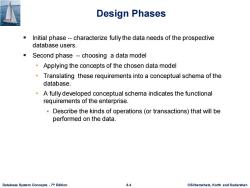
Design Phases Initial phase--characterize fully the data needs of the prospective database users. Second phase--choosing a data model Applying the concepts of the chosen data model Translating these requirements into a conceptual schema of the database. A fully developed conceptual schema indicates the functional requirements of the enterprise. Describe the kinds of operations (or transactions)that will be performed on the data. Database System Concepts-7th Edition 6.4 @Silberschatz,Korth and Sudarshan
Database System Concepts - 7 6.4 ©Silberschatz, Korth and Sudarshan th Edition Design Phases ▪ Initial phase -- characterize fully the data needs of the prospective database users. ▪ Second phase -- choosing a data model • Applying the concepts of the chosen data model • Translating these requirements into a conceptual schema of the database. • A fully developed conceptual schema indicates the functional requirements of the enterprise. ▪ Describe the kinds of operations (or transactions) that will be performed on the data
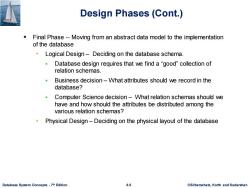
Design Phases(Cont.) Final Phase--Moving from an abstract data model to the implementation of the database Logical Design-Deciding on the database schema. Database design requires that we find a "good"collection of relation schemas. Business decision-What attributes should we record in the database? Computer Science decision-What relation schemas should we have and how should the attributes be distributed among the various relation schemas? Physical Design-Deciding on the physical layout of the database Database System Concepts-7th Edition 6.5 ©Silberscha乜,Korth and Sudarshan
Database System Concepts - 7 6.5 ©Silberschatz, Korth and Sudarshan th Edition Design Phases (Cont.) ▪ Final Phase -- Moving from an abstract data model to the implementation of the database • Logical Design – Deciding on the database schema. ▪ Database design requires that we find a “good” collection of relation schemas. ▪ Business decision – What attributes should we record in the database? ▪ Computer Science decision – What relation schemas should we have and how should the attributes be distributed among the various relation schemas? • Physical Design – Deciding on the physical layout of the database
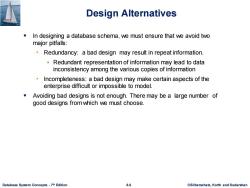
Design Alternatives In designing a database schema,we must ensure that we avoid two major pitfalls: Redundancy:a bad design may result in repeat information. Redundant representation of information may lead to data inconsistency among the various copies of information 。 Incompleteness:a bad design may make certain aspects of the enterprise difficult or impossible to model. Avoiding bad designs is not enough.There may be a large number of good designs from which we must choose. Database System Concepts-7th Edition 6.6 ©Silberscha乜,Korth and Sudarshan
Database System Concepts - 7 6.6 ©Silberschatz, Korth and Sudarshan th Edition Design Alternatives ▪ In designing a database schema, we must ensure that we avoid two major pitfalls: • Redundancy: a bad design may result in repeat information. ▪ Redundant representation of information may lead to data inconsistency among the various copies of information • Incompleteness: a bad design may make certain aspects of the enterprise difficult or impossible to model. ▪ Avoiding bad designs is not enough. There may be a large number of good designs from which we must choose
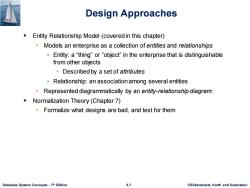
Design Approaches Entity Relationship Model(covered in this chapter) Models an enterprise as a collection of entities and relationships Entity:a "thing"or"object"in the enterprise that is distinguishable from other objects Described by a set of attributes Relationship:an association among several entities Represented diagrammatically by an entity-relationship diagram: Normalization Theory (Chapter 7) Formalize what designs are bad,and test for them Database System Concepts-7th Edition 6.7 ©Silberscha乜,Korth and Sudarshan
Database System Concepts - 7 6.7 ©Silberschatz, Korth and Sudarshan th Edition Design Approaches ▪ Entity Relationship Model (covered in this chapter) • Models an enterprise as a collection of entities and relationships ▪ Entity: a “thing” or “object” in the enterprise that is distinguishable from other objects • Described by a set of attributes ▪ Relationship: an association among several entities • Represented diagrammatically by an entity-relationship diagram: ▪ Normalization Theory (Chapter 7) • Formalize what designs are bad, and test for them
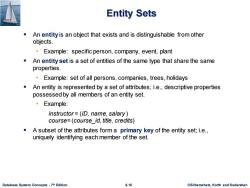
Entity Sets An entity is an object that exists and is distinguishable from other objects Example:specific person,company,event,plant An entity set is a set of entities of the same type that share the same properties. Example:set of all persons,companies,trees,holidays An entity is represented by a set of attributes;i.e.,descriptive properties possessed by all members of an entity set. ·Example: instructor=(ID,name,salary) course=(course_id,title,credits) A subset of the attributes form a primary key of the entity set;i.e., uniquely identifying each member of the set. Database System Concepts-7th Edition 6.10 ©Silberscha乜,Korth and Sudarshan
Database System Concepts - 7 6.10 ©Silberschatz, Korth and Sudarshan th Edition Entity Sets ▪ An entity is an object that exists and is distinguishable from other objects. • Example: specific person, company, event, plant ▪ An entity set is a set of entities of the same type that share the same properties. • Example: set of all persons, companies, trees, holidays ▪ An entity is represented by a set of attributes; i.e., descriptive properties possessed by all members of an entity set. • Example: instructor = (ID, name, salary ) course= (course_id, title, credits) ▪ A subset of the attributes form a primary key of the entity set; i.e., uniquely identifying each member of the set
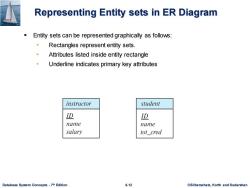
Representing Entity sets in ER Diagram Entity sets can be represented graphically as follows: Rectangles represent entity sets. Attributes listed inside entity rectangle Underline indicates primary key attributes instructor student D D name name salary tot cred Database System Concepts-7th Edition 6.12 @Silberschatz,Korth and Sudarshan
Database System Concepts - 7 6.12 ©Silberschatz, Korth and Sudarshan th Edition Representing Entity sets in ER Diagram ▪ Entity sets can be represented graphically as follows: • Rectangles represent entity sets. • Attributes listed inside entity rectangle • Underline indicates primary key attributes

Relationship Sets A relationship is an association among several entities Example: 44553(Peltier) advisor 22222(Einstein) student entity relationship set instructor entity A relationship set is a mathematical relation among n>2 entities,each taken from entity sets {(e1,e2,.en)|e1∈E1,e2∈E2,,en∈Enl where (e1,e2,...,e)is a relationship ·Example: (44553,22222)∈advisor Database System Concepts-7th Edition 6.13 ©Silberscha乜,Korth and Sudarshan
Database System Concepts - 7 6.13 ©Silberschatz, Korth and Sudarshan th Edition Relationship Sets ▪ A relationship is an association among several entities Example: 44553 (Peltier) advisor 22222 (Einstein) student entity relationship set instructor entity ▪ A relationship set is a mathematical relation among n 2 entities, each taken from entity sets {(e1 , e2 , … en ) | e1 E1 , e2 E2 , …, en En } where (e1 , e2 , …, en ) is a relationship • Example: (44553,22222) advisor

Relationship Sets (Cont.) Example:we define the relationship set advisorto denote the associations between students and the instructors who act as their advisors. ■ Pictorially,we draw a line between related entities. 76766 Crick 98988 Tanaka 45565 Katz 12345 Shankar 10101 Srinivasan 00128 Zhang 98345 Kim 76543 Brown 76543 Singh 76653 Aoi 22222 Einstein 23121 Chavez instructor 44553 Peltier student Database System Concepts-7th Edition 6.14 ©Silberschat乜,Korth and Sudarshan
Database System Concepts - 7 6.14 ©Silberschatz, Korth and Sudarshan th Edition Relationship Sets (Cont.) ▪ Example: we define the relationship set advisor to denote the associations between students and the instructors who act as their advisors. ▪ Pictorially, we draw a line between related entities
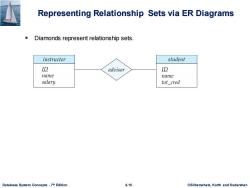
Representing Relationship Sets via ER Diagrams Diamonds represent relationship sets. instructor student ID advisor D name name salary tot_cred Database System Concepts-7th Edition 6.15 @Silberschatz,Korth and Sudarshan
Database System Concepts - 7 6.15 ©Silberschatz, Korth and Sudarshan th Edition Representing Relationship Sets via ER Diagrams ▪ Diamonds represent relationship sets
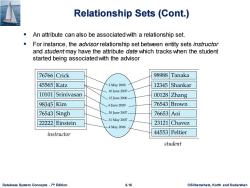
Relationship Sets (Cont.) An attribute can also be associated with a relationship set. ■ For instance,the advisorrelationship set between entity sets instructor and student may have the attribute date which tracks when the student started being associated with the advisor 76766 Crick 98988 Tanaka 45565 Katz 3May2008 12345 Shankar 10June2007 10101 Srinivasan 00128 12June2006 Zhang 98345 Kim 6 June 2009 76543 Brown 76543 Singh 30June2007 76653Aoi 31May2007 22222 Einstein 23121 Chavez 4May2006 instructor 44553 Peltier student Database System Concepts-7th Edition 6.16 @Silberschatz,Korth and Sudarshan
Database System Concepts - 7 6.16 ©Silberschatz, Korth and Sudarshan th Edition Relationship Sets (Cont.) ▪ An attribute can also be associated with a relationship set. ▪ For instance, the advisor relationship set between entity sets instructor and student may have the attribute date which tracks when the student started being associated with the advisor instructor student 76766 Crick Katz Srinivasan Kim Singh Einstein 45565 10101 98345 76543 22222 98988 12345 00128 76543 44553 Tanaka Shankar Zhang Brown Aoi Chavez Peltier 3 May 2008 10 June 2007 12 June 2006 6 June 2009 30 June 2007 31 May 2007 4 May 2006 76653 23121
按次数下载不扣除下载券;
注册用户24小时内重复下载只扣除一次;
顺序:VIP每日次数-->可用次数-->下载券;
- 《数据库系统概念 Database System Concepts》原书教学资源(第七版,PPT课件讲稿,英文版)Chapter 05 Advanced SQL.pptx
- 《数据库系统概念 Database System Concepts》原书教学资源(第七版,PPT课件讲稿,英文版)Chapter 04 Intermediate SQL.pptx
- 《数据库系统概念 Database System Concepts》原书教学资源(第七版,PPT课件讲稿,英文版)Chapter 31 Information Retrieval.pptx
- 《数据库系统概念 Database System Concepts》原书教学资源(第七版,PPT课件讲稿,英文版)Chapter 30 XML.pptx
- 《数据库系统概念 Database System Concepts》原书教学资源(第七版,PPT课件讲稿,英文版)Chapter 03 Introduction to SQL.pptx
- 《数据库系统概念 Database System Concepts》原书教学资源(第七版,PPT课件讲稿,英文版)Chapter 29 Object-Based Databases.pptx
- 《数据库系统概念 Database System Concepts》原书教学资源(第七版,PPT课件讲稿,英文版)Chapter 28 Advanced Relational Database Design.pptx
- 《数据库系统概念 Database System Concepts》原书教学资源(第七版,PPT课件讲稿,英文版)Chapter 27 Formal-Relational Query Languages.pptx
- 《数据库系统概念 Database System Concepts》原书教学资源(第七版,PPT课件讲稿,英文版)Chapter 26 Blockchain Databases.pptx
- 《数据库系统概念 Database System Concepts》原书教学资源(第七版,PPT课件讲稿,英文版)Chapter 25 Advanced Application Development.pptx
- 《数据库系统概念 Database System Concepts》原书教学资源(第七版,PPT课件讲稿,英文版)Chapter 24 Advanced Indexing.pptx
- 《数据库系统概念 Database System Concepts》原书教学资源(第七版,PPT课件讲稿,英文版)Chapter 23 Parallel and Distributed Transaction Processing.pptx
- 《数据库系统概念 Database System Concepts》原书教学资源(第七版,PPT课件讲稿,英文版)Chapter 22 Parallel and Distributed Query Processing.pptx
- 《数据库系统概念 Database System Concepts》原书教学资源(第七版,PPT课件讲稿,英文版)Chapter 21 Parallel and Distributed Storage.pptx
- 《数据库系统概念 Database System Concepts》原书教学资源(第七版,PPT课件讲稿,英文版)Chapter 20 Database System Architectures.pptx
- 《数据库系统概念 Database System Concepts》原书教学资源(第七版,PPT课件讲稿,英文版)Chapter 02 Intro to Relational Model.pptx
- 《数据库系统概念 Database System Concepts》原书教学资源(第七版,PPT课件讲稿,英文版)Chapter 19 Recovery System.pptx
- 《数据库系统概念 Database System Concepts》原书教学资源(第七版,PPT课件讲稿,英文版)Chapter 18 Concurrency Control.pptx
- 《数据库系统概念 Database System Concepts》原书教学资源(第七版,PPT课件讲稿,英文版)Chapter 17 Transactions.pptx
- 《数据库系统概念 Database System Concepts》原书教学资源(第七版,PPT课件讲稿,英文版)Chapter 16 Query Optimization.pptx
- 《数据库系统概念 Database System Concepts》原书教学资源(第七版,PPT课件讲稿,英文版)Chapter 07 Normalization.pptx
- 《数据库系统概念 Database System Concepts》原书教学资源(第七版,PPT课件讲稿,英文版)Chapter 08 Complex Data Types.pptx
- 《数据库系统概念 Database System Concepts》原书教学资源(第七版,PPT课件讲稿,英文版)Chapter 09 Application Development.pptx
- 计算机科学与技术教学资源(参考文献)The generalized Cholesky factorization method for saddle point problems.pdf
- 计算机科学与技术教学资源(参考文献)Inverse updating and downdating for weighted linear least squares using M-invariant reflections.pdf
- 计算机科学与技术教学资源(参考文献)Analysis of peaks and plateaus in a Galerkin/minimal residual pair of methods.pdf
- 计算机科学与技术教学资源(参考文献)Perturbation analysis for the generalized Cholesky factorization.pdf
- 计算机科学与技术教学资源(参考文献)STABILITY OF THE MATRIX FACTORIZATION FOR SOLVING BLOCK TRIDIAGONAL SYMMETRIC INDEFINITE LINEAR SYSTEMS.pdf
- 计算机科学与技术教学资源(参考文献)A Convergent Restarted GMRES Method For Large Linear Systems.pdf
- 计算机科学与技术教学资源(参考文献)Properties and Computations of Matrix Pseudospectra.pdf
- 计算机科学与技术(参考文献)A Novel Constrained Texture Mapping Method Based on Harmonic Map.pdf
- 计算机科学与技术(参考文献)A Robust and Fast Non-local Algorithm for Image Denoising.pdf
- 计算机科学与技术(参考文献)Efficient View Manipulation for Cuboid-Structured Images.pdf
- 计算机科学与技术(参考文献)Ensemble of trusted firmware services based on TPM.pdf
- 计算机科学与技术(参考文献)Fuzzy Quantization Based Bit Transform for Low Bit-Resolution Motion Estimation.pdf
- 计算机科学与技术(参考文献)Image Completion based on Views of Large Displacement.pdf
- 计算机科学与技术(参考文献)Image and Video Retexturing.pdf
- 计算机科学与技术(参考文献)Learning-Based 3D Face Detection Using Geometric Context.pdf
- 计算机科学与技术(参考文献)Multi-view Video Summarization.pdf
- 计算机科学与技术(参考文献)Mesh-Guided Optimized Retexturing for Image and Video.pdf
